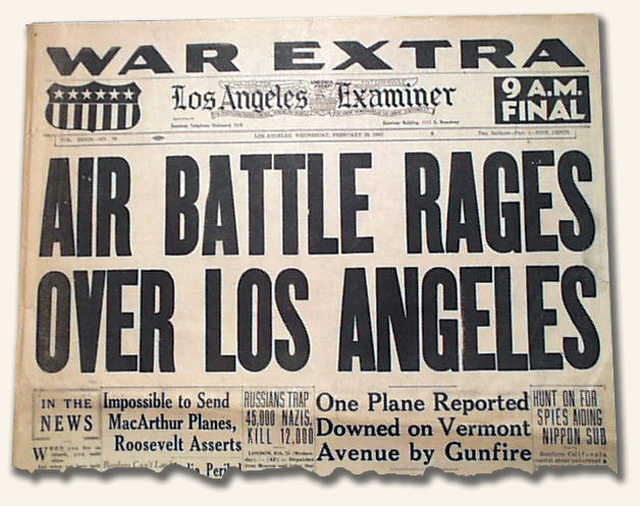The date is the 25 February 1942 and its been less than three months since the Japanese attack on Pearl Harbor and only one day after the bombardment of Ellwood. As a result, fear of another Japanese attack is very high.
On the evening of the 24th, air raid sirens were sounded and a total blackout ordered in the Californian city of Los Angeles. The city was ready for what they believed to be an Axis attack. The 37th Coast Artillery fired preemptive shells into the air at unidentified objects. 25 planes were reportedly sighted as the sky lit up with artillery strikes.
1,400 shells were fired into the night sky and the all-clear was only given at 7.21am. Five US civilians died in the confusion from car accidents and heart attacks.
As morning broke, the news came through that the entire night’s firing was a false alarm. But what did the anti-aircraft teams see and what did they fire at?

The following ideas were put forward: (some plausible, some nuts)
- Japanese psychological warfare
- Japanese submarines off the coast of L.A.
- US military false alarm
- Secret Axis base in Northern Mexico
There was also a UFO theory but we’ll leave that to conspiracy theorists…
The official reason was given the morning after. The Secretary of the Navy Frank Knox held a press conference, saying the entire incident was a false alarm due to anxiety and war nerves. It was most likely the anti-aircraft shell bursts that were caught in the searchlights and mistaken for enemy aircraft. The incident was then seemingly laid to rest as the USA waded into the war.

The event was brought back into the public eye by the Stephen Spielberg film 1941. A comedy movie, it mocked the events and the fear in the USA at the time. Later in 1983, the Office of Air Force History concluded that meteorological balloons were the cause of the alarm and panic. Their official report can be seen here
So, all in all a very unfortunate episode for the USA. It just goes to show how war can affect whole communities and even nations psychologically.
For more stories from World War II, pick up the new issue of History of War or subscribe now and save 30% off the cover price.
